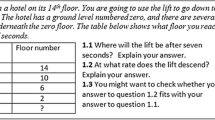Abstract
Identifying and expressing relations between quantities is a key aspect of understanding and using functions. We are aiming to understand the development of functions understanding throughout school years in Israel. A survey instrument was developed with teachers and given to 20 high and average achieving students from each of years 7–11 and to 10 high achieving students from year 12, a total of 110 students. Our analytical approach is to identify qualitatively what students appeared to do and whether their approaches led to complete solutions. We look for progress in understanding variables and relations between them, and we found that there does not appear to be a strong link between curriculum and informal understandings of variables and covariation, but there are other strengths.



Similar content being viewed by others
Notes
Straight line graphs include proportional and affine relations; we use ‘linear’ for all these in common with curricula and school-based use of the term.
References
Ayalon, M., Lerman, S. & Watson, A. (2013). Development of students’ understanding of functions throughout school years. Proceedings of the British Society for Research into Learning Mathematics, 33(2), 7–12.
Ayalon, M., Lerman, S. & Watson, A. (2014a). Progression towards understanding functions: What does spatial generalization contribute? Proceedings of BCME 8, 17–24.
Ayalon, M., Lerman, S. & Watson, A. (2014b). Graph-matching situations: Some insights from cross years survey in the UK. Research in Mathematics Education, 16(1), 73–74.
Blanton, M. L. & Kaput, J. J. (2011). Functional thinking as a route into algebra in the elementary grades. In J. Cai & E. Knuth (Eds.), Early algebraization: A global dialogue from multiple perspectives (pp. 5–23). Berlin, Germany: Springer.
Carlson, M., Jacobs, S., Coe, E., Larsen, S. & Hsu, E. (2002). Applying covariational reasoning while modeling dynamic events: A framework and a study. Journal for Research in Mathematics Education, 33(5), 352–378.
Confrey, J. & Smith, E. (1994). Exponential functions, rates of change, and the multiplicative unit. Educational Studies in Mathematics, 26, 135–164.
Confrey, J. & Smith, E. (1995). Splitting, covariation, and their role in the development of exponential functions. Journal for Research in Mathematics Education, 26(1), 66–86.
Dreyfus, T. & Eisenberg, T. (1982). Intuitive functional concepts: A baseline study on intuitions. Journal for Research in Mathematics Education, 13(5), 360–380.
Goldenberg, E. P. (1987). Believing is seeing: How preconceptions influence the perceptions of graphs. In J. Bergeron, N. Herscovits & C. Kieran (Eds.), Proceedings of the 11th Conference of the International group for the Psychology of Mathematics Education, 1, 197–203.
Herbert, S. & Pierce, P. (2012). Revealing educationally critical aspects of rate. Educational Studies in Mathematics, 81, 85–101.
Janvier, C. (1981). Use of situations in mathematics education. Educational Studies in Mathematics, 12, 113–122.
Leinhardt, G., Zaslavsky, O. & Stein, M. (1990). Functions, graphs and graphing: Tasks, learning and teaching. Review of Educational Research, 60(1), 1–64.
Mevarech, Z. & Kramarsky, B. (1997). From verbal descriptions to graphic representations: Stability and change in students’ alternative conceptions. Educational Studies in Mathematics, 32, 229–263.
Ministry of Education (2009). Math curriculum for grades 7–9. Retrieved from http://meyda.education.gov.il/files/Tochniyot_Limudim/Math/Hatab/Mavo.doc (in Hebrew)
Orton, A. (1983). Students’ understanding of differentiations. Educational Studies in Mathematics, 14, 235–250.
Orton, J., Orton, A. & Roper, T. (1999). Pictorial and practical contexts and the perception of pattern. In A. Orton (Ed.), Patterns in the teaching and learning of mathematics. London, England: Cassell.
Radford, L. (2000). Signs and meanings in students’ emergent algebraic thinking: A semiotic analysis. Educational Studies in Mathematics, 42, 237–268.
Radford, L. (2008). Iconicity and contraction: A semiotic investigation of forms of algebraic generalizations of patterns in different contexts. ZDM – The International Journal on Mathematics Education, 40, 88–96.
Rivera, F. D. & Becker, J. R. (2008). Middle school children’s cognitive perceptions of constructive and deconstructive generalizations involving linear figural patterns. ZDM: International Journal in Mathematics Education, 40, 65–82.
Sajka, M. (2003). A secondary school student’s understanding of the concept of function—A case study. Educational Studies in Mathematics, 53, 229–254.
Schultz, K., Clement, J. & Mokros, J. (1986). Adolescents’ graphing skills: A descriptive analysis. Paper presented at the meeting of the American Educational Research Association, San Francisco, California.
Stacey, K. (1989). Finding and using patterns in linear generalizing problems. Educational Studies in Mathematics, 20, 147–164.
Swan, M. (1980). The language of functions and graphs. Nottingham: Shell Centre for Mathematical Education. University of Nottingham, Nottingham, UK.
Van Dooren, W., De Bock, D., Hessels, A., Janssens, D. & Verschaffel, L. (2005). Not everything is proportional: Effects of age and problem type on propensities for overgeneralization. Cognition and Instruction, 23, 57–86.
Vinner, S. & Dreyfus, T. (1989). Images and definitions for the concept of function. Journal for Research in Mathematics Education, 20, 356–366.
Wilmot, D. B., Schoenfeld, A. H., Wilson, M., Champney, D. & Zahner, W. (2011). Validating a learning progression in mathematical functions for college readiness. Mathematical Thinking and Learning, 13(4), 259–291.
Author information
Authors and Affiliations
Corresponding author
Rights and permissions
About this article
Cite this article
Ayalon, M., Watson, A. & Lerman, S. Progression Towards Functions: Students’ Performance on Three Tasks About Variables from Grades 7 to 12. Int J of Sci and Math Educ 14, 1153–1173 (2016). https://doi.org/10.1007/s10763-014-9611-4
Received:
Accepted:
Published:
Issue Date:
DOI: https://doi.org/10.1007/s10763-014-9611-4




